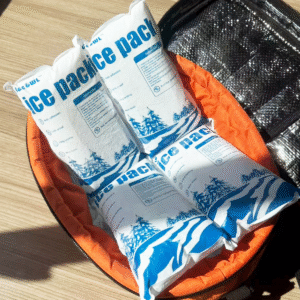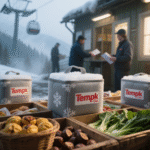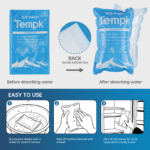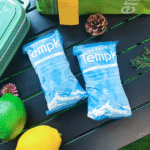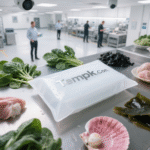Si vous apprenez Comment utiliser des packs de glace sèche, Commencez par type, préconditionnement, superposition, emballage serré, et les contrôles de température. Utilisez des «packs de glace sec» en gel / PCM pour les prises congelées au refroidissement ou à la lumière, et de la glace sèche réelle pour les voies de la référence profonde. Suivez les règles de la compagnie aérienne et d'expédition, et garder les aliments à ou moins de 40 ° F (4°C) pour la sécurité. Vous trouverez tout ce dont vous avez besoin ici - simple, testé, et prêt à l'emploi.
-
Choisir des réfrigérants: Lorsque Gel / PCM bat CO₂, et où chacun brille pour la chaîne froide de longue distance.
-
Dimensionnement et runtime: Un estimateur rapide des packs de taille droite pour l'heure et la masse de chargement.
-
Comment emballer: Méthode «couche et séparée» étape par étape pour éviter les dommages du froid et prolonger le temps de maintien.
-
Règles et sécurité: 2025 TSA Gel-Cack-Crack et FAA Limites de glace sèche expliquées en anglais ordinaire.
-
Playbooks réels: Glacière, colis, et des scénarios de vol que vous pouvez copier aujourd'hui.
Comment utiliser des packs de glace sec vs. gel / pcm - quelle est la différence?
Réponse courte: La plupart des «packs de glace sec» que vous achetez sont du gel scellé ou des packs PCM, pas de co₂. Les packs Gel / PCM maintiennent une température définie (pour refroidissement ou soft-cozen), sont réutilisables, et n'a pas besoin de ventilation. Vraie glace sèche (Co₂) se trouve à -78,5 ° C / −109 ° F, nécessite des emballages ventilés et de l'approbation des compagnies aériennes, et est le meilleur pour les flèches profondes. Utilisez du gel / PCM pour les prises de 2 à 8 ° C; Choisissez −15 ° C PCMS ou Co₂ pour les voies congelées.
Pourquoi ça compte: Vous protégez votre produit en faisant correspondre le point de fusion / gel vers votre zone cible. Choisissez des gels 0 à 5 ° C pour les produits et les médicaments, −15 ° C PCMS pour les titulaires de «congélateur» sans CO₂, et co₂ uniquement pour ultra-froid ou long, routes chaudes. C'est le moyen le plus simple de maîtriser comment utiliser les packs de glace sèche.
Comment utiliser des packs de glace sec pour 2 à 8 ° C ou des voies congelées
Choisissez le réfrigérant qui fond près de votre consigne. PCMS APLAPER LES SWINGS DE TEMPÉRATION Pendant qu'ils se sont efforcés de phase, Alors vos marchandises évitent les pointes. Condition préalable correctement (8–12h pour les gels 0 ° C; 24–36H pour les panneaux −15 ° C) et ajouter des barrières minces entre les packs et les aliments délicats pour éviter la «brûlure de glace». Ceci est l'épine dorsale pratique de la façon d'utiliser des packs de glace sec sans dommage au contenu.
| Option de refroidissement | Point de gel / fusion | Manutention & règles | Ce que cela signifie pour vous |
|---|---|---|---|
| Gel standard "Pack de glace sèche" | ~ 0 ° C / 32 ° F | Pas de danger; Aucun évent nécessaire | Idéal pour 2 à 8 ° C. Doux sur les produits / biologiques. |
| Pack de congélateur PCM | −15 ° C / 5 ° F | Pas de danger; long pré-référence | «Cordeau de congé. |
| Vraie glace sèche (Co₂) | −78,5 ° C / −109 ° F | Emballage ventilé; approbation des compagnies aériennes | Flèches profondes et longues voies; gants et étiquetage requis. |
Conseils pratiques que vous pouvez utiliser aujourd'hui
-
Séparé & couche: Placez un mince carton ou rack entre les packs et les articles fragiles.
-
Entourer la charge utile: Côtés + Top dans les colis; bas + Top pour les glacières gelées.
-
Remplir les vides: Les serviettes ou Dunnage vainaient les lacunes chaudes et prolongent l'exécution.
Cas en bref: Un expéditeur de pâtisse. Après 30 heures et plusieurs reprises, La masse centrale est restée en dessous de 10 ° F, et les garnitures aux fruits n'ont montré pas de gel.
Comment utiliser les packs de glace sec étape par étape pour l'expédition?
Séquence de base: Précondition → Couper → Séparer → Emballage serré → Évent (Co₂ seulement) → Moniteur. Cette commande maximise le temps de maintien et la qualité du produit. Pour Gel / PCM «Packs de glace sèche,«La ventilation n'est pas requise; pour co₂, c'est obligatoire. Utilisez un thermomètre - ne devinez pas.
Procédure à pas détaillée: Confirmer le type de pack; Préfréablement au point de spécification; Ajouter des séparateurs; entourer la charge utile; remplir les vides; Placer un thermomètre; Et si vous utilisez Co₂, porter des gants, Étiquette un1845, et permettre au gaz de s'échapper. Cette routine disciplinée est le moyen le plus sûr de pratiquer comment utiliser les packs de glace sec à grande échelle.
Estimateur d'emballage (copie de copie)
Estimer le nombre de packs de gel / pcm de 1 kg pour les prises de 2 à 8 ° C:
-
Conditionsfactor: 0.8 (froid / ombre), 1.0 (normale), 1.2–1.4 (chaud / ensoleillé, ouverture fréquente)
-
Un gel de 1 kg 0 ° C donne ~ un jour pour ~ 2 kg de charge utile dans un expéditeur décent; Ajuster la chaleur et l'accès.
| Guide de préconditionnement | Point typique | Temps de préparation | Ce que cela signifie pour vous |
|---|---|---|---|
| Pack de gel standard | 0 ° C / 32 ° F | 8–12h | Idéal pour 2 à 8 ° C; revirement plus rapide. |
| Panneau de congélateur PCM | −15 ° C / 5 ° F | 24–36h | Temps d'exécution plus long; Corableau sans CO₂. |
| Vraie glace sèche (Co₂) | −78,5 ° C | Acheter le jour même | Free de profondeur uniquement; TOUJOURS ÉVALAGE. |
Déplacements d'emballage testés sur le terrain
-
Pour la nourriture réfrigérée: Couche inférieure de gels 0 ° C, charge utile, Un gel sur le dessus; rester ombragé.
-
Pour les produits surgelés: Panneaux −15 ° C sur les côtés + haut; Contenu de préfregé; Ajouter un tampon de gel près des éléments délicats.
-
Pour les charges mixtes: Utilisez du CO₂ près de la zone de la reget profonde et des gels / pcm comme tampons près des éléments sensibles; Boîte extérieure de ventilation.
Comment utiliser des packs de glace sec pour les vols sans tracas?
TSA (gel / pcm): Vous pouvez transporter des packs de gel ou de congélateur s'ils sont gelés solides à la sélection; Les packs médicalement nécessaires peuvent être slushy - les éclater.
FAA (Co₂): Max 2,5 kg (5.5 kg) par passager / colis; approbation de l'opérateur; emballage ventilé; «glace sèche / dioxyde de carbone, Marquage solide avec la quantité nette. Construisez votre plan de voyage autour de ces deux règles, Et vous saurez exactement comment utiliser des packs de glace sec aux jours de vol.
Liste de contrôle de transport
-
Greeze emballe solide et placez-vous au bas de votre sac plus frais.
-
Attendez-vous à un dépistage secondaire si un pack est slushy; mentionner les besoins médicaux tôt.
-
Laissez clairement des chemins de ventilation pour co₂ et étiquetez clairement les agents.
Comment utiliser des packs de glace sec dans des glacières pour le camping et les excursions d'une journée?
Pour les boissons et les produits laitiers (2–8 ° C), tapisser le fond avec des gels 0 ° C, ajouter de la nourriture, et garnir d'un gel. Pour la viande ou le poisson surgelée, Exécutez des panneaux de −15 ° C le long des côtés et du haut, et garder un petit gel 0 ° C entre les articles congelés et «Chill-Only». Limiter les ouvertures de couvercle, Gardez une petite glacière «day-use», et enveloppez le principal refroidisseur si vous devez le stocker sous le soleil direct.
2025 Mises à jour et tendances de la chaîne froide
Quoi de neuf: Les systèmes PCM réutilisables et les doublures recyclables en bordure de bordure se développent rapidement, Alors que les équipes coupent les déchets sans sacrifier le temps de maintien. Plus de voies à la paire des PCM avec une surveillance des conditions pour moins d'excursions. Le résultat pour utiliser les packs de glace sec: hybrides plus intelligents, meilleure isolation, et des sentiers d'audit plus clairs.
Dernier en un coup d'œil
-
Expéditeurs PCM réutilisables: Grandir régulièrement; réduire les consommables et le coût total par navire.
-
Doublures à base de fibres: Plus de conceptions d'amitié avec des performances thermiques solides.
-
Surveillance IoT traditionnelle: Les enregistreurs de température sont désormais standard sur les voies critiques.
Perspicacité du marché: Attendez-vous à un TCAC continu de 5 à 9% dans les segments d'emballage à la chaîne froide à la fin des années 2020, Dirigée par les sciences de la vie et les grandes grandes. Conception pour les flux de réutilisation et la disponibilité du PCM lorsque vous normalisez comment utiliser les packs de glace sèche sur les réseaux.
FAQ: Comment utiliser des packs de glace sèche
Combien dois-je utiliser pour les routes de 24 à 72 h?
Planifier ~ 5 à 10 lb par 24h pour les petites parcelles avec une bonne isolation; Ajouter le tampon pour la chaleur ou les retards. Testez sur votre itinéraire avant de mettre à l'échelle.
Sont des «packs de glace sec» réelles de la glace sèche?
Habituellement pas. La plupart sont des packs Gel / PCM commercialisés sous forme de «packs de glace sec». La vraie glace sèche est solide et beaucoup plus froide. Vérifiez la fiche des spécifications.
Les packs Gel / PCM ont-ils besoin de ventilation?
Non. La ventilation est uniquement pour la glace sèche car elle libère du gaz car il se réchauffe.
La nourriture est-elle sûre avec des packs le touchant?
Utilisez une fine barrière (serviette / carton). Gardez les aliments réfrigérés ≤40 ° F (4 ° C) et confirmer avec un thermomètre.
Puis-je apporter des packs via TSA?
Oui, Si gelé solide à la dépistage; Les packs médicalement nécessaires peuvent être slushy - les éclater.
Résumé & étapes suivantes
Points clés: Confirmer Gel / PCM vs Co₂, condition préalable à la spécification, couche avec des séparateurs, emballage, et surveiller les températures. Suivez les règles de prise en gel TSA et les limites de la FAA à la glace sèche, et garder les aliments ≤40 ° F (4 ° C). C'est la façon fiable de maîtriser comment utiliser les packs de glace sèche.
Votre plan d'action:
-
Définir la zone de retenue (2–8 ° C, −15 ° C, ou la réflexion profonde).
-
Choisissez des packs: 0–5 ° C Gels pour refroidir; −15 ° C PCMS pour le congélateur; Co₂ pour ultra-froid.
-
Utilisez l'estimateur pour dimensionner la masse et exécuter un pilote avec un bûcheron.
-
Standardiser un emballage SOP et Train Teams. Besoin d'aide? Réservez une consultation gratuite avec l'équipe de la chaîne froide de Tempk.
À propos du tempk
Nous aidons les équipes à concevoir Playout Playbooks et calculatrices basées sur les données pour la nourriture périssable, biopharma, et marchandises spécialisées. Nos conseils reflètent les règles actuelles de la TSA / FAA / PHMSA et des options PCM modernes, Alors vos envois restent conformes, prévisible, et rentable. Nous testons dans de vraies routes et publions modèles de marque Votre équipe peut utiliser immédiatement.
Appel à l'action: Parlez à un spécialiste du Tempk Cold-Chain - Réservez une consultation gratuite.






